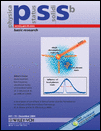Effect of a liquid pressure-transmitting medium on the high pressure behavior of open- and closed-end single-walled carbon nanotubes and of C60-peapods
Abstract
In situ synchrotron X-ray diffraction measurements of three types of single-walled carbon nanotubes (SWNTs) (open- and closed-end, and C60-peapod samples) under high pressure using a cubic anvil press with a liquid-pressure-transmitting-medium (LPTM) were carried out. Comparing with a previous experiment using a solid-pressure-transmitting-medium, it was found that the high pressure behavior of SWNT bundles is much affected by the LPTM. In order to investigate the dependence of the LPTM effect on the tube-end structure, in situ Raman scattering measurements were also performed. (© 2004 WILEY-VCH Verlag GmbH & Co. KGaA, Weinheim)




